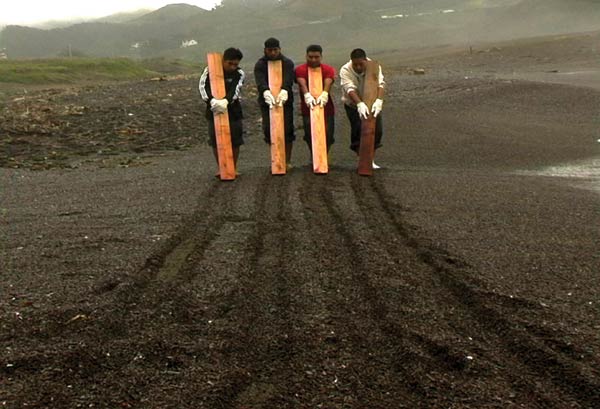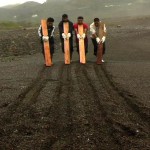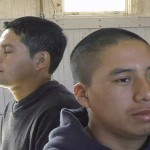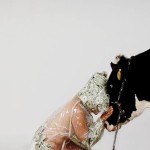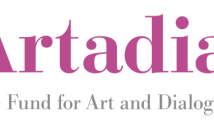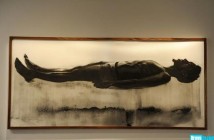CARLSON/STROM: NEW PERFORMANCE VIDEO @ THE DECORDOVA
"There are, therefore, common patterns in various experiences, no matter how unlike they are to one another in the details of their subject matter. There are conditions to be met without which an experience cannot come to be."
- John Dewey, 1934
It takes great skill to create work that not only references art historical moments but also is able to move beyond it. It is deceptively easy to do in terms of form but conceptually? This is much harder to achieve. Art history pervades all the work that artists make. How can it not? To be unaware of the work that precedes is to make work in a dark room. Sure, this is possible but can it be any good? The work of Ann Carlson and Mary Ellen Strom is often (if not always) informed by the past. Their work has grappled with colonialism, the history of the American west, and the performative aspects of every day life. In navigating these concepts Carlson/Strom have created work that not only looks forward but is acutely aware of its position historically.
This navigation is most evident in their current exhibition at the DeCordova Museum and Sculpture Park: Carlson/Strom: New Performance Video. There are five pieces included in the show. The videos range from the straightforward performance documentation to a six channel immersive installation that is the centerpiece of the exhibition. The work is at times accessible and at others a bit opaque. I say this not as a criticism but more as an observation. Contemporary video work too often veers towards the didactic. You would think that after over forty years as a medium people would have figured out that video art doesn’t have to be simplistic to be successful. I would rather see something that offers a moment of perplexity then video that telegraphs it’s meaning across a crowded room.
That said, there are moments in the show where the video is the video and nothing more. One of the more profound and moving pieces is Cuenta. Here four day laborers (who are also participants in the video Four Parallel Lines) are recorded in a gymnasium repeating and performing bits of songs, daily rituals, and other experiential moments from their lives. The camera moves in and out of their personal space focusing on a face or forehead in one moment and an article of clothing in the next. It is a raw moment that is evocative of the work of Michael Snow or early Joan Jonas. It is visceral and I felt that it stood in contrast to the staged character of the other work. It’s placement also worked rather well. I liked the fact that one comes across it while navigating the dark galleries.
The other four pieces are much more formal and deal more explicitly with art historical moments. Although based upon Walter De Maria’s piece Two Parallel Lines or Mile Long Drawing from 1968, I couldn’t help but think of the work of Allan Kaprow as I watched Four Parallel Lines. The video consists of four day laborers (those mentioned above) who pull planks of wood equal to their own size along a beach in Marin County. As they follow the shoreline the tide moves in eliminating any trace of their journey. It is an elegant simple video that speaks volumes. It is about the marking of humans on the environment but also about the invisibility of labor. And what I felt links it to Kaprow’s work is that it is experiential and ephemeral. The men moved along the shore, over and over again, in a futile struggle with the tide.
In a room adjoining Four Parallel Lines hangs Sloss, Kerr, Rosenberg & Moore, a video I have had the chance to see before. I am glad I had because it’s installation here diluted much of its power. The placement and lack of soundproofing really irked me here. I know that sound is always an issue in a video show. I have installed a couple in my time. It is hard to do, yet not impossible. Sound is key toSloss, Kerr, Rosenberg & Moore. In this piece four attorneys stand in an elevator lobby performing moments from their day-to-day existence. In an age where the lawyer is one of our most mediated figures it is an interesting insight into the personalities, shortcomings, and tribulations of attorneys in our culture. Their comments and mutterings do a lot to illustrate their foibles and insecurities and it is a very strong piece. Or it would have been if the audio weren’t drowned out by the neighboring video. It was disappointing.
The most elaborate installation of the exhibition is Meadowlark. The piece is a collaboration between Mary Ellen Strom, Ann Carlson, and Bently Spang. The video is comprised of six separate flat panel monitors reminiscent of cycloramas of the late nineteenth and early twentieth century (and if you have been to Paris recently then it is like the Monet’s hanging in the Musee d´Orangerie). This is certainly the most ambitious of the work in this show. You enter a darkened space and the six monitors float in space around you. The images track across, moving from monitor to monitor and sometimes displaying an image that surrounds you. It is powerful yet not easily comprehensible. It is elusive. The video is striking and powerful. Carlson/Strom walk a fine line here that is probably helped by the presence of Bently Spang, a Northern Cheyenne artist. What could have been a heavy-handed investigation of ecological and cultural destruction instead comes across as a thoughtful exploration. It is not only firmly rooted in the artist’s history of critically looking at the west but it also draws inspiration from the archetypal western painting Indians Simulating Buffalo by Frederic Remington from 1908. The piece deftly avoids literalist interpretations of cultural and environmental destruction and instead offers up an alternative window into the American west.
The final piece in the show is another analysis of an art historical moment, Joseph Beuys performance/installation from 1974: Coyote: I like America and America Likes Me. The difference is that instead of Beuys and a coyote there is Ann Carlson and a cow. EntitledMadame 710 (the name of the Holstein cow who performs with Carlson) the video is a three-channel installation that, on the surface, explores our relationship with animals and money (Carlson is wearing a plastic suit partially filled with dollar bills) but when thought through (and informed by the knowledge of the Beuys piece) is much more complicated. With its deft editing and rearranging of time flow (it moves forwards and backwards and has moments of slow motion) the video takes upon a depth that outstrips its formal construction. There is a pathos inherent in the relationship between Carlson and #710. While I was watching the video numerous children ran about the gallery and laughed at the naked woman dancing with the cow. It was in that moment that I realized what was going on. Ann Carlson and Mary Ellen Strom created a video that on its surface is absurd and lighthearted. A cow and a woman in a gallery? Why that is crazy! But dig deeper and the story is far darker and more complicated. Like all of their work, the surface image is deceiving. Carlson/Strom lure you in with beautiful and well-constructed visuals but linger a bit and you’ll get a glimpse of a critical eye that is telling you all is not well with our society.
- Mary Ellen Strom and Ann Carlson, Four Parallel Lines, video projection, 2007.
- Mary Ellen Strom and Ann Carlson, Cuenta, video projection, 2007.
- Mary Ellen Strom and Ann Carlson, Madame 710, 3-channel video projection, 2008.
DeCordova Museum and Sculpture Park
"Carlson/Strom: New Performance Video" is on view January 24 through May 17, 2009 at the DeCordova Museum and Sculpture Park.
All images are courtesy of the artists and the DeCordova Museum and Sculpture Park.

